
You know you’ve stumbled onto something special when even your tour guide, someone who has done this exact thing countless times, is stunned into near-silence.
“Whoa… yeah…” says the disarmingly handsome, and usually eloquent Anthony O’Hern, who runs Dove Lake Kayak tours. “Today is pretty special. When the water is glass like this, it looks like a huge mirror.”
Reflected in that mirror, its craggy peaks piercing the sky like the blade of a serrated knife, soars Cradle Mountain.
“Yep,” I hear Anthony mutter, mostly to himself. “Today is a special one.”
The rarity of our situation is underscored by its timing. If this were summer, you’d call our idyllic kayak excursion lucky. The fact our wooden boats are gliding through the inky water in the weeks before winter, while a soft morning sun warms our necks, makes it remarkable.
So why, I hear you asking, have we come to Tasmania — for a water activity no less — at a time when most of us prefer to migrate north for warmer climes? Well, here’s the thing: slowly but surely, Tassie is becoming one of Australia’s hottest winter destinations.
Part of its pull lies in its many winter festivals, such as Dark Mofo, Bridport’s Scallop Fiesta and the tremendous Whisky Week (trust us, check it out), but there’s also a sneaking suspicion that Tasmanians, with their clean crisp air and stunning scenery, know how to do winter better than most.
To test the theory, we’ve planned a five-day tour of the Apple Isle, starting in Cradle Mountain before circumnavigating Lake St Clair in Tassie’s chilly north-west for a stay at one of Australia’s most stunning hotels: Pumphouse Point. Devil encounters, bushwalks, ancient trees and delectable local produce await. Time to rug up and chill out.
After a bumpy landing in Launceston our Tassie adventure begins with a visit to the bustling Christmas Hills Raspberry Farm. Created 40 years ago from a single raspberry plant and a roadside stall — “This was nan’s side hustle in the ’80s,” laughs general manager Scott Dornauf — the family-owned farm has since expanded into a thriving business set on freshly landscaped grounds. It’s the perfect place to fill our stomachs (be sure to try the nostalgic raspberry spider) before we jump into the car for the easy 90-minute drive to Cradle Mountain.
Awaiting us is a tour of the renowned Wilderness Gallery, which forms part of our overnight accommodation at Cradle Mountain Hotel. First opened in 2003 and now lovingly and expertly curated by hotel manager Brogan, the gallery’s purpose is to showcase the work of artists who either hail from Tasmania or have a strong connection to the island. It features nine exhibition halls, but a highlight is the space dedicated to famed photographer Peter Dombrovskis, whose powerful shots of Tassie’s wilderness form the only permanent collection.
It’s our next experience, however, that I’ve been looking forward to most: an encounter with a Tassie devil. We’ve booked an ‘after dark feeding tour’ with Devils@Cradle, and it’s quickly apparent it’s not for the faint-hearted.
“It’s going to be like Jurassic Park in here soon,” says our guide Sarah with a glint in her eye. “There’ll be plenty of screaming, some grunting and biting, and lots of bone crunching!”
The words are ominous enough, but Sarah is also holding a devil in the crook of her arm, like a gigantic, deadly cat. “Want to pat him?” she asks, before adding, “Don’t worry, Noah is a big sook.”
Noah’s fur is surprisingly coarse (his doleful brown eyes close sleepily as he’s stroked) but it’s nothing compared to his table manners. With a wallaby carcass hung over a post in the ground, our night ends as we watch the devils tear away hunks of flesh, their blood-curdling screams and growls carrying on the breeze.
It’s kayak day, and while you already know we got lucky with the weather, the appeal of this adventure lies beyond the mercurial whim of the gods. We start early and Anthony hands us our life jackets and waterproof gear (“No one has fallen in yet, but there’s always a first,” he chuckles) before we drag our two-man kayaks to the water’s edge. The kayaks are works of art and, amazingly, each is lovingly handmade by Anthony from ultra-rare, salvaged King Billy pine.
“It’s the best wood to make boats out of because it’s so light and strong,” Anthony tells us as we clamber in, our feet splashing in the cold, incredibly clear water. “Each one probably takes me about 200 hours, or six months to make.”
They certainly feel far more special than piloting a hunk of gaudy, brightly coloured plastic, and their superior design is immediately obvious. We cut through the water effortlessly and our tour quickly takes on a kind of meditative rhythm as we paddle towards Cradle Mountain. Anthony is a superb guide, peppering our journey with just enough history of Dove Lake’s Jurassic-era landscape for it to be interesting, while also allowing long periods of quiet for us to properly drink it all in.
Progress is swift and we’re soon parking up on a beach at the lake’s far end. Anthony busies himself making us a hot chocolate and passing around a container of Kingstons (the best cream biscuit?). Then his annoyingly fit physique is leading us into the trees for a lesson on the forest’s mix of pines, beeches and Australia’s only native deciduous tree, the famous fagus, which turns the landscape gorgeous shades of yellow, red and plum in autumn.
The main attraction, though, is a gigantic King Billy pine. “That one is around 2000 years old,” Anthony whispers with barely disguised awe. “They have to be at least 700 before you can even consider cutting them down, but it’s been illegal to harvest them because there’s so few left.” With the return leg dispatched, we retire to the wonderfully appointed Cradle Mountain Hotel to rest sore arms and fill empty tummies. Tomorrow we head to Pumphouse.
If you’re planning a trip to Tasmania, NRMA members enjoy sizeable discounts at both Cradle Mountain Hotel and Pumphouse Point. Both properties are part of the NRMA Parks and Resorts portfolio.
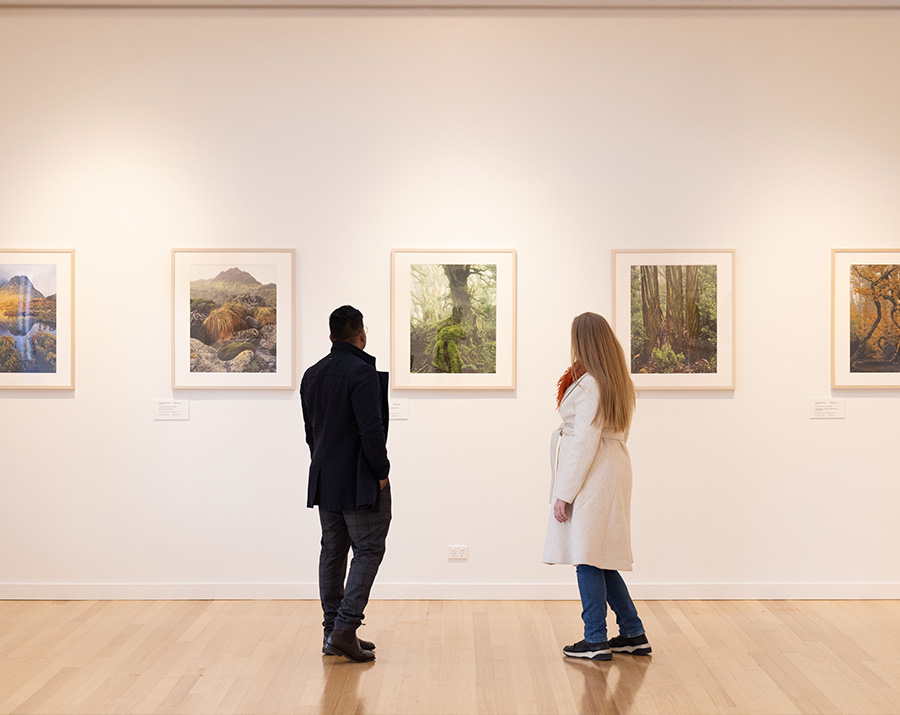
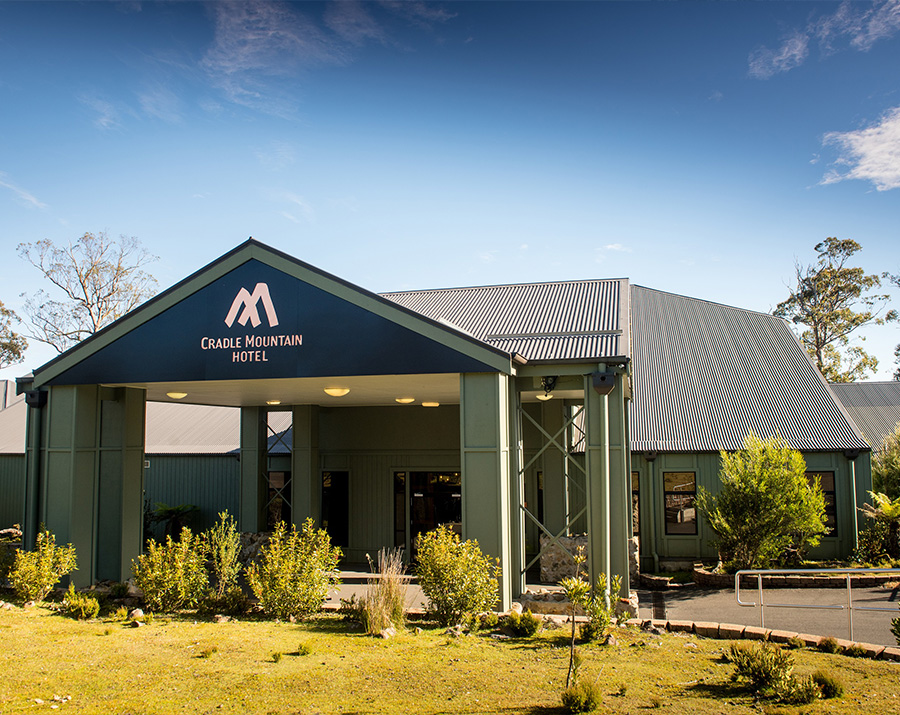
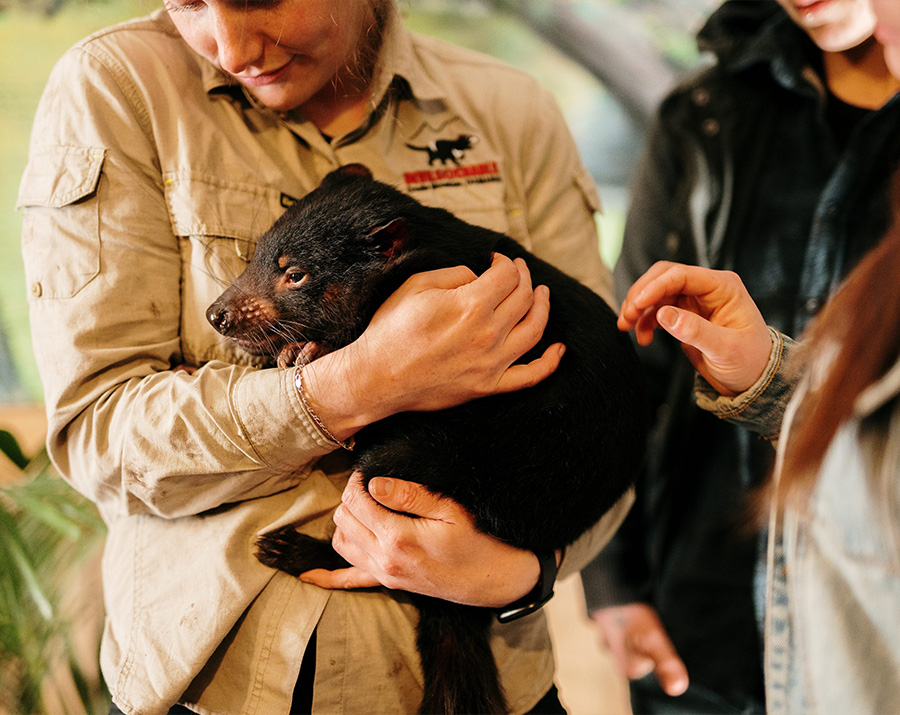
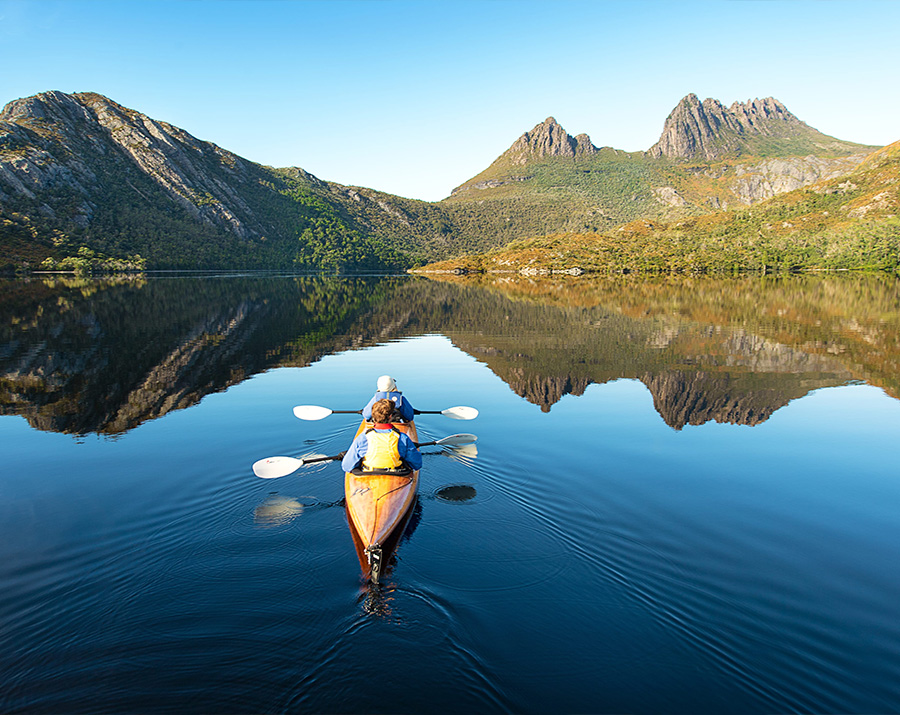
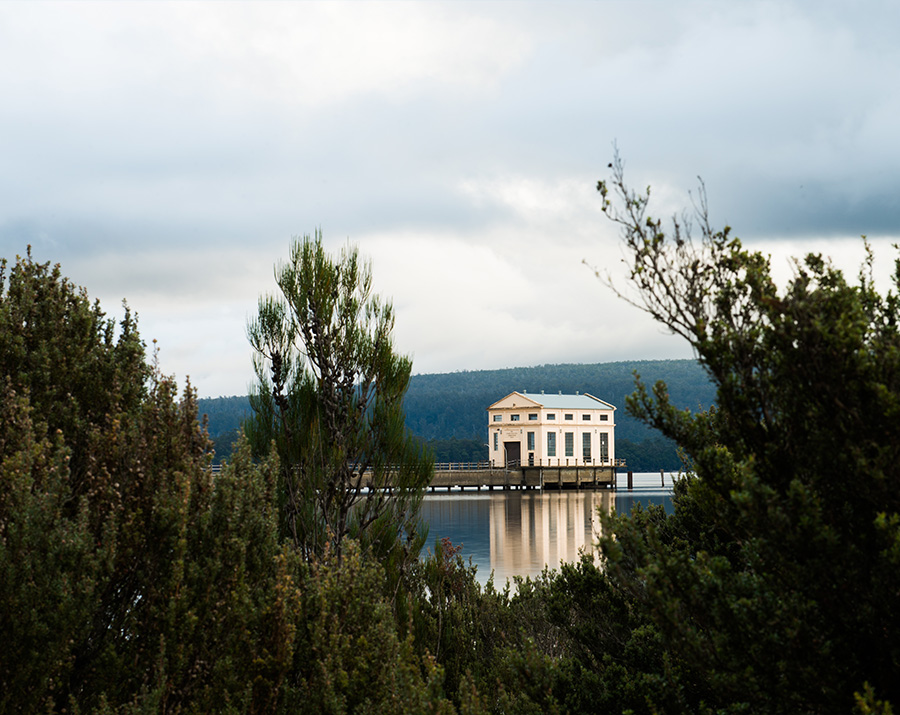
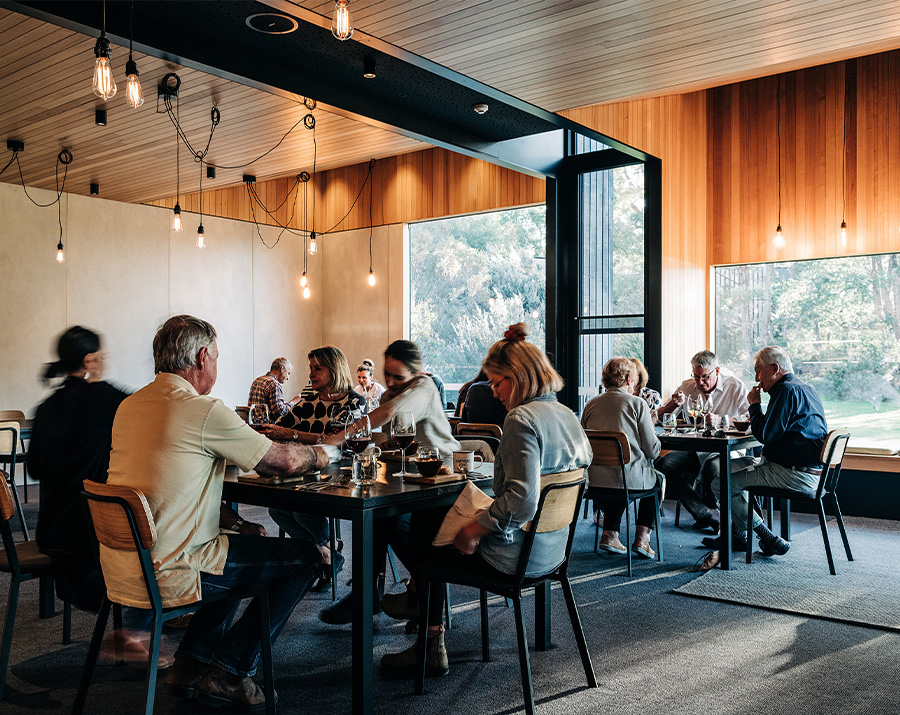
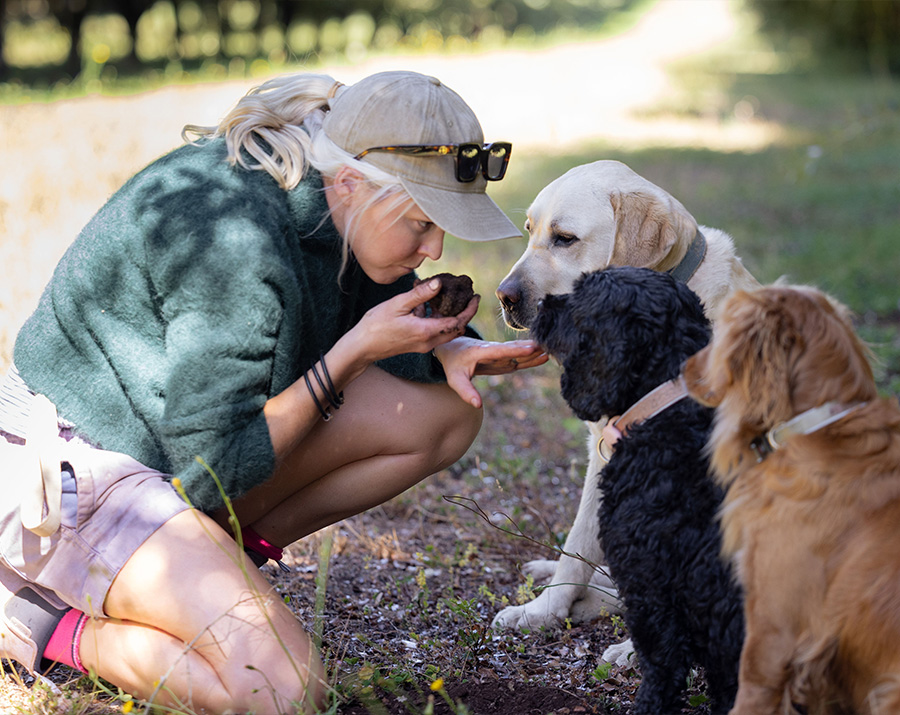
Much like Michael Jackson and Lady Gaga, Pumphouse Point knows how to make a dramatic entrance.
Perched 240 metres offshore in Australia’s deepest freshwater lake, its white Art Deco walls shine like a beacon as we cruise slowly into the hotel’s grounds. It has taken us 3.5 hours to get here and it’s the quiet and solitude that strike you first. While Cradle Mountain was hardly overrun with people, it’s clearly a destination designed for visitors to get out and explore. At Pumphouse, the hotel is the destination. Time, as a result, seems to slow.
We’re greeted with a glass of champagne before hotel manager Asanga leads us on a tour of the grounds. Completed in 1939 as part of Tassie’s hydro-electric scheme, the pumphouse once held four enormous pumps capable of expelling 28,000 litres of water per second, before it was converted into a hotel in 2015.
The result is a truly unique experience. There are 12 rooms in the pumphouse itself, with another six in the old substation (known as the Shorehouse), and one ultra-exclusive ‘retreat’ nestled amongst the trees on the shoreline. Plans to add two additional retreats have just been completed.
We’re staying on the water, and while our room is compact, there’s no faulting the view from its floor-to-ceiling windows or the luxury of its fitout. We begin to decompress with games of Finska, long stints in front of the fire, and picnic lunches (a well-stocked larder is provided each day) within the national park’s astonishingly well-preserved bushland. Even the weather is playing ball, with heavy clouds adding a welcome layer of cosiness.
Dinners are communal at Pumphouse, and I initially have some reservations about eating with strangers, but it proves to be a great way to mingle. The food itself is exquisite, with a carefully crafted menu highlighting local produce. By the time you read this, things will likely have been elevated even further. Its nearby sister property is the recently purchased and renovated Derwent Bridge Wilderness Hotel, whose larger commercial kitchen will be used to offer guests a five-star degustation experience.
Can you describe the flavour of truffle? As we drive towards Australia’s oldest truffle farm, which is the final destination on our Tassie tour, I realise I can’t. Earthy is all I can come up with, but it feels too obvious.
“It’s a hard one!” laughs Anna, who runs The Truffle Farm after it was established by her parents in 1999. “Earthy is right, but it’s also umami [savoury], with tones of nuttiness, and I can pick up hints of raspberry.”
I nod along in acknowledgement, yet I’m only partly listening because trotting around us, their tails wagging in furious greeting, are the farm’s truffle dogs. They’re a big deal here — an enormous metal statue of one dog, aptly named ‘Doug’, sits near the entrance — and soon we get to see them in action. As well as its picture-perfect shopfront, The Truffle Farm runs foraging tours, and it’s fascinating to see how joyfully the dogs go about their work.
“We hunt for 60 hours per week for 10 months of the year,” says Anna. “It’s important the dogs are on the ball all the time. If they lose concentration for four or five trees, we could lose half a kilo of product.”
As if he was listening, Doug suddenly paws at the ground before Anna swoops in to gently uncover a precious black truffle, a substance so valuable it’s measured in grams, not kilos. “We’re one of the only farms to have both a winter and summer plantation,” says Anna as she shaves the freshly foraged, and incredibly delicious, truffle into our hands for a taste. “So, you can visit us all year round.”
Unwittingly, I realise Anna has perfectly articulated how I’m starting to feel about Tasmania. While it’s unquestionably lovely in the warmer months, there’s something unique about visiting the Apple Isle in winter. Tasmanians don’t grin and bear the cold like the rest of us; they seem to embrace it. I urge you to do the same.